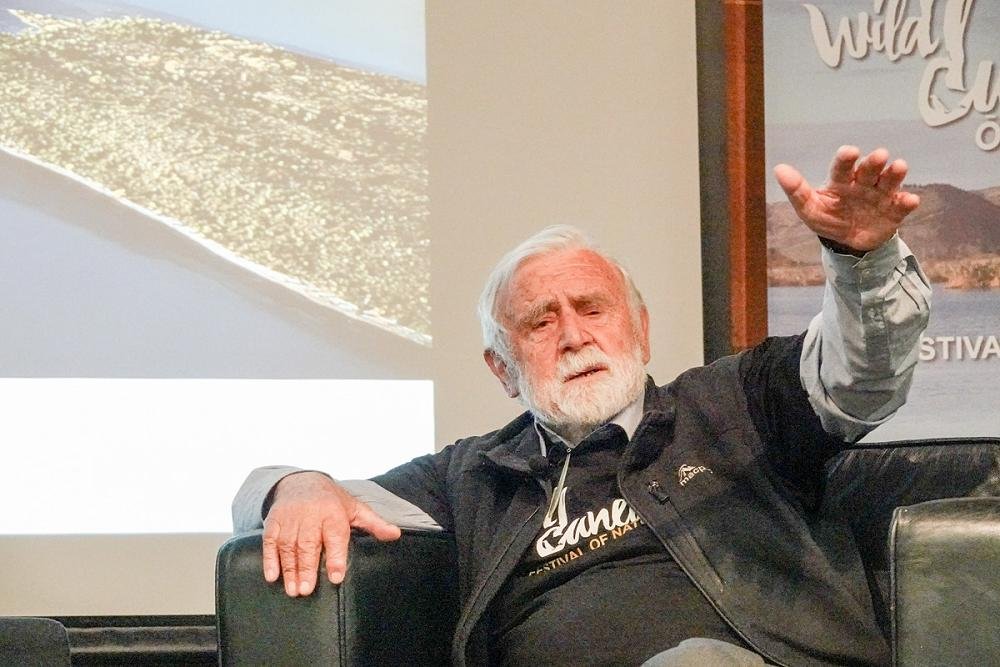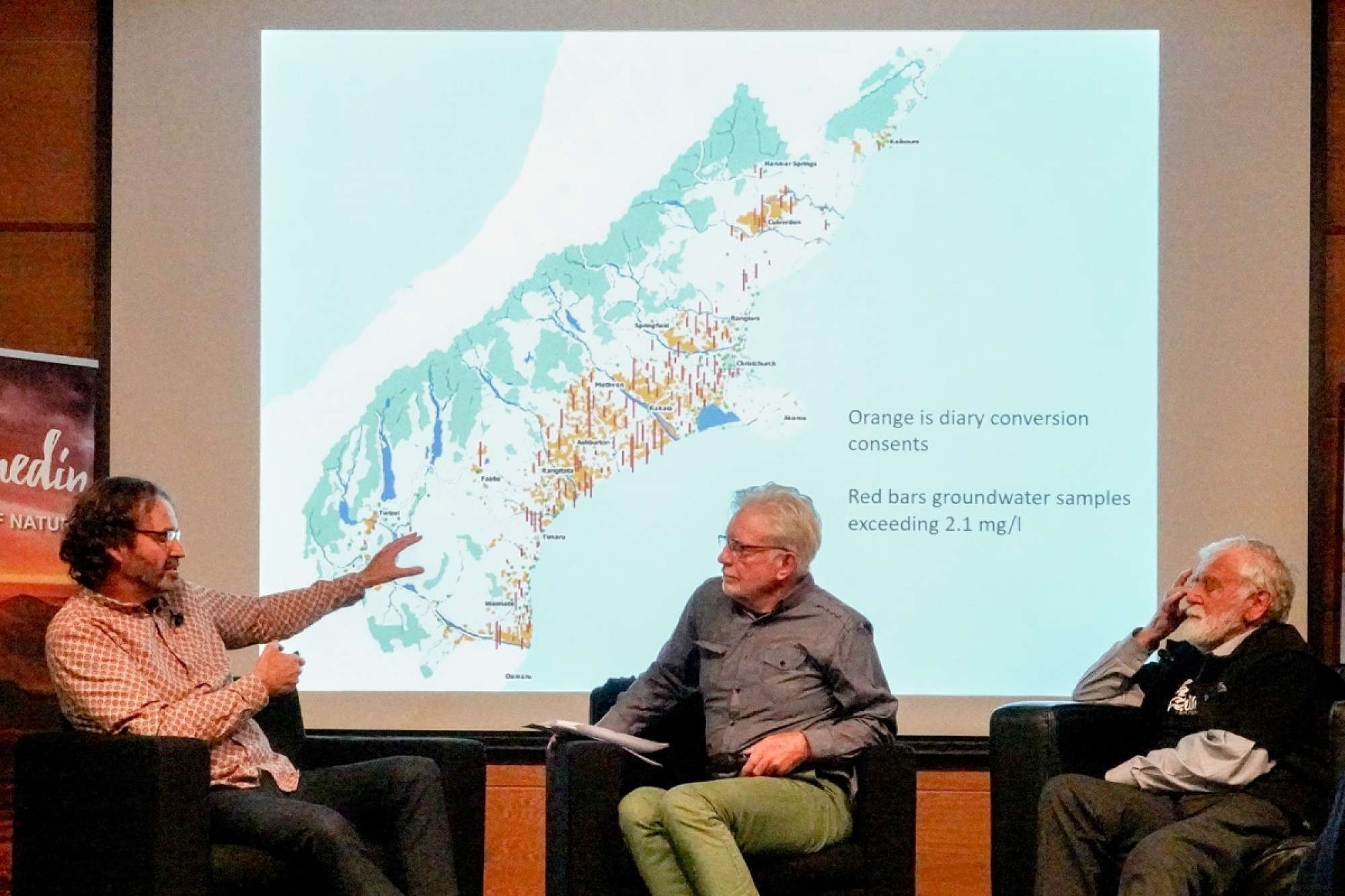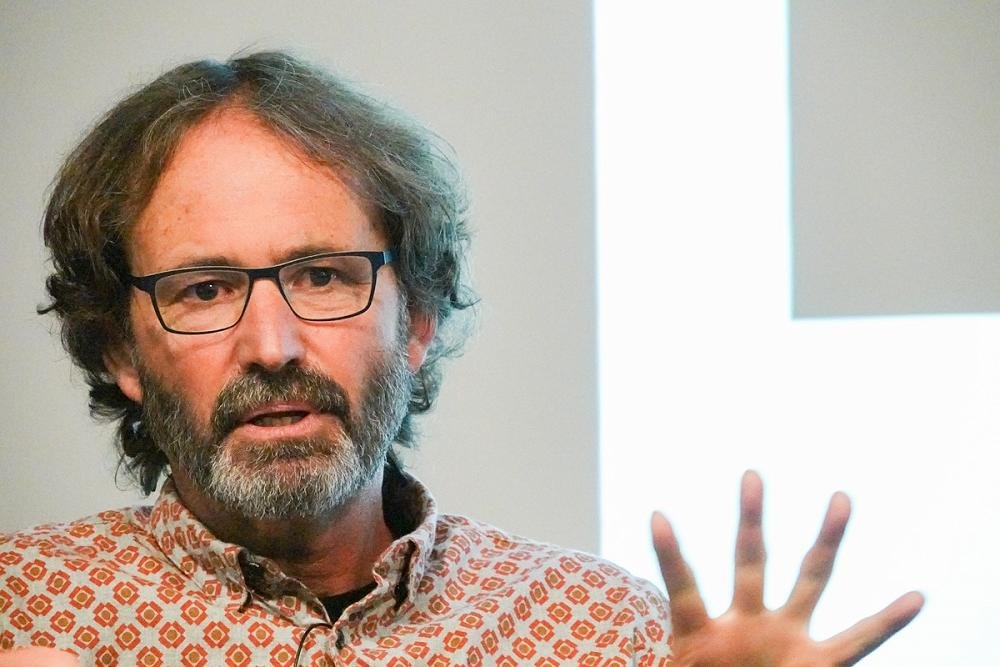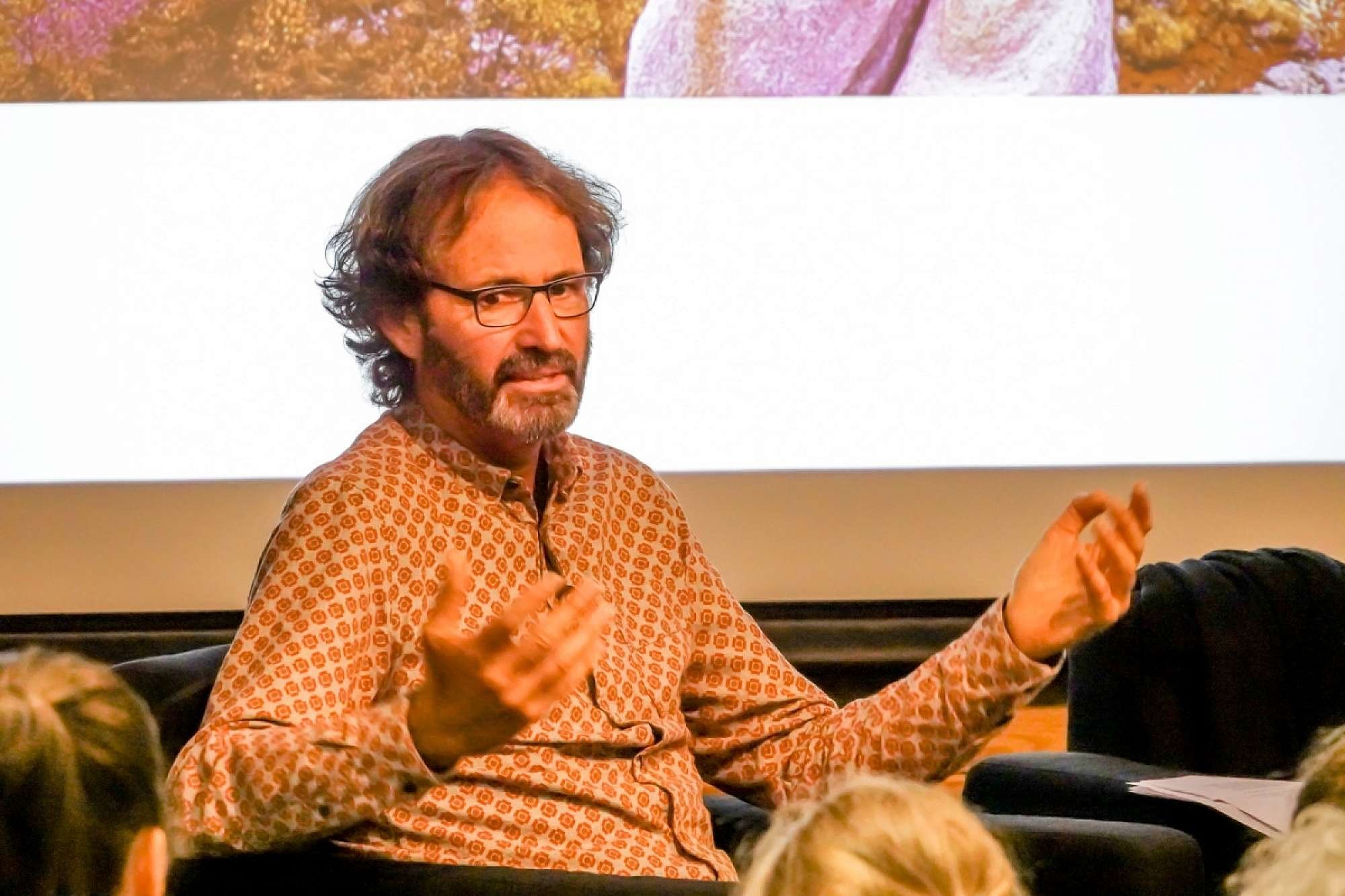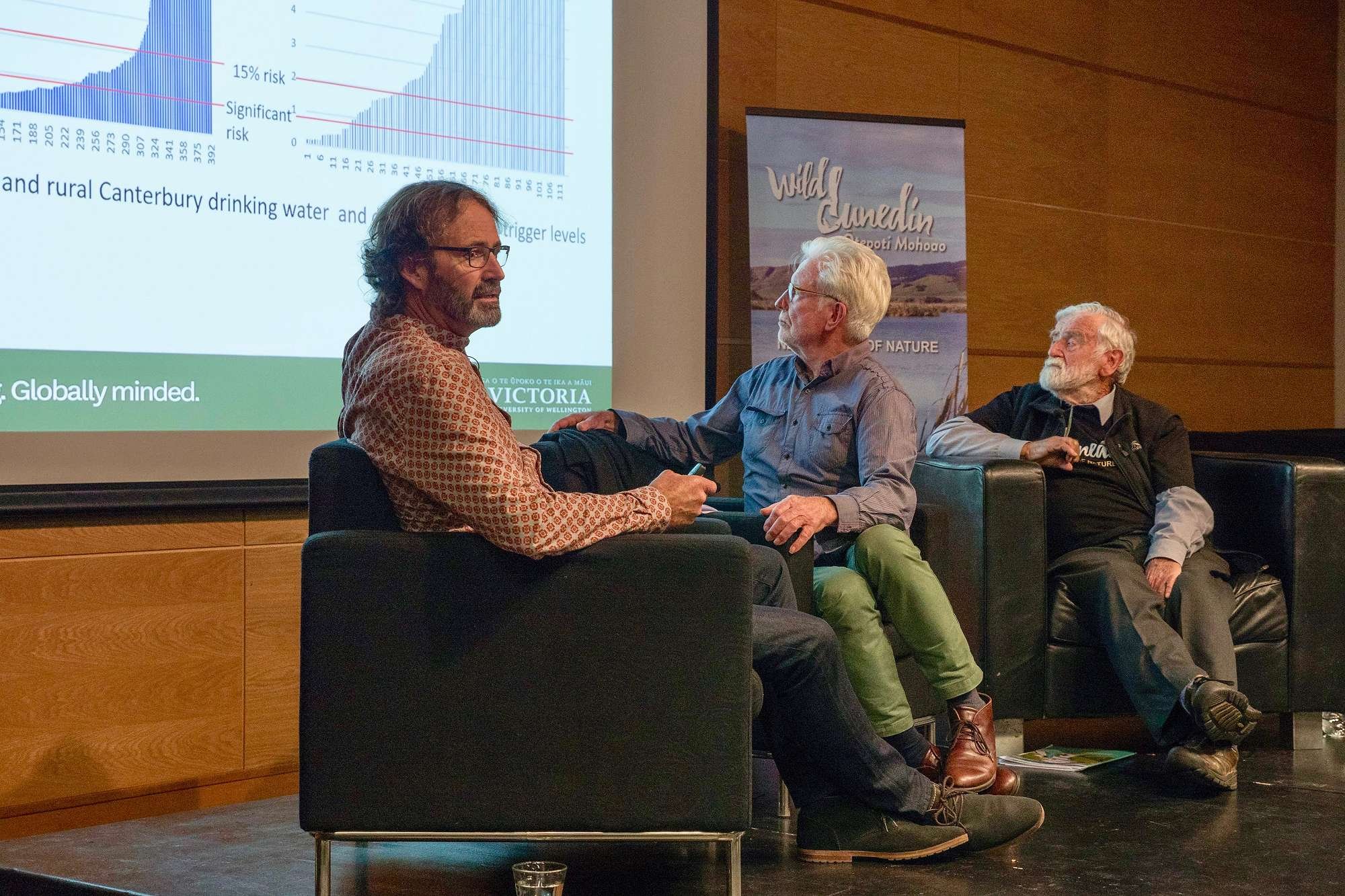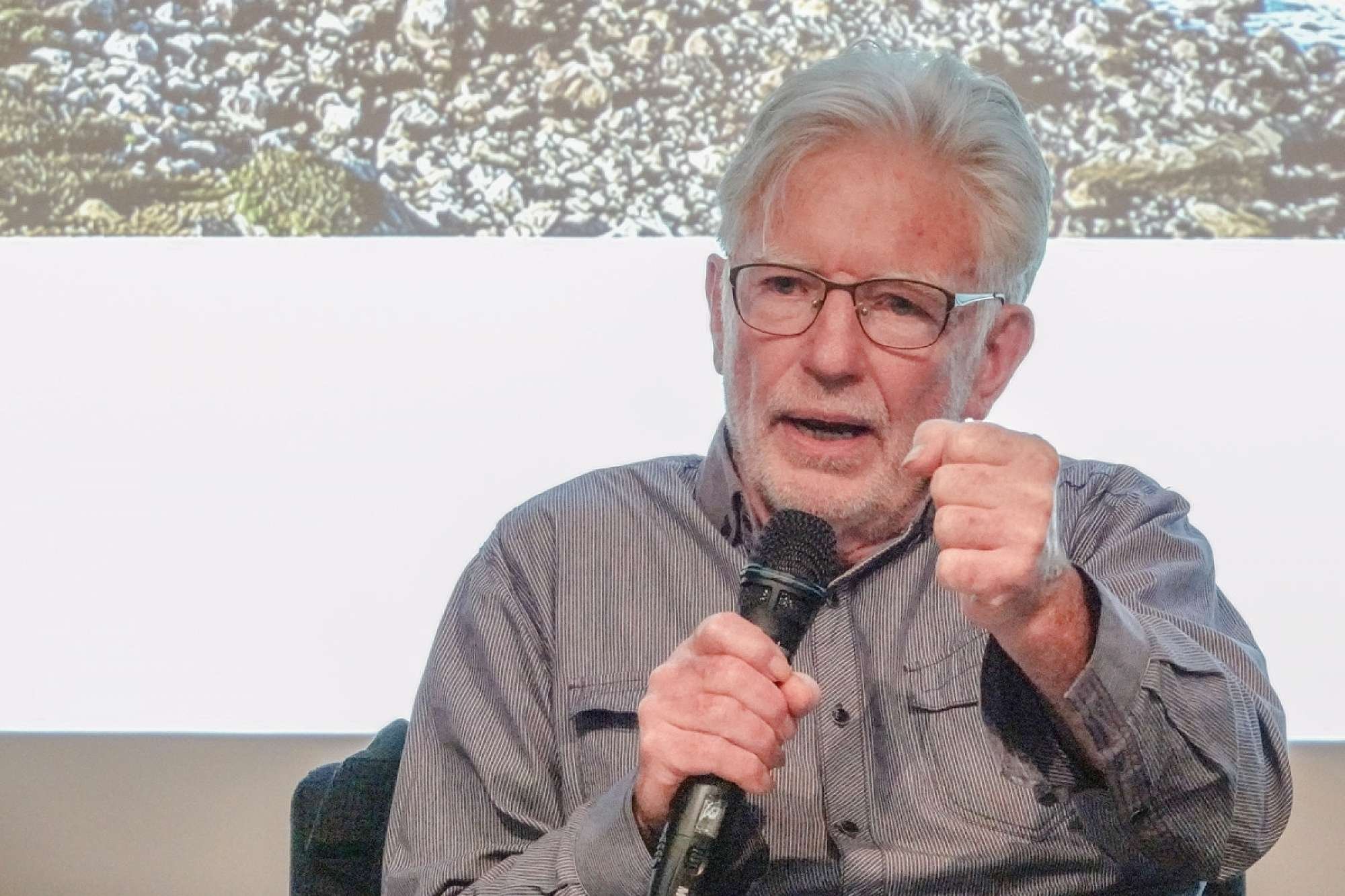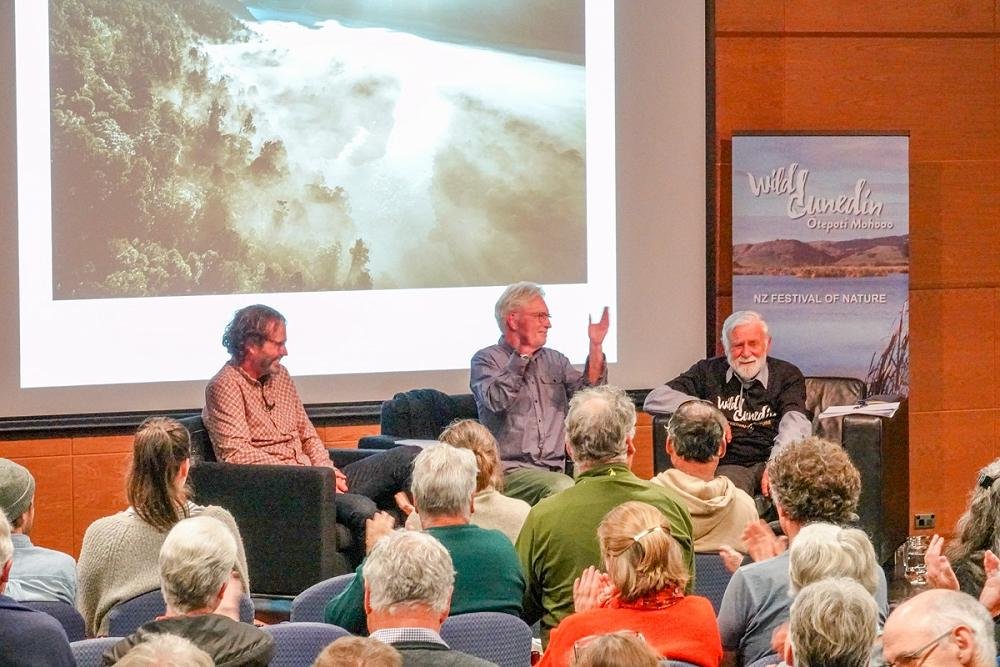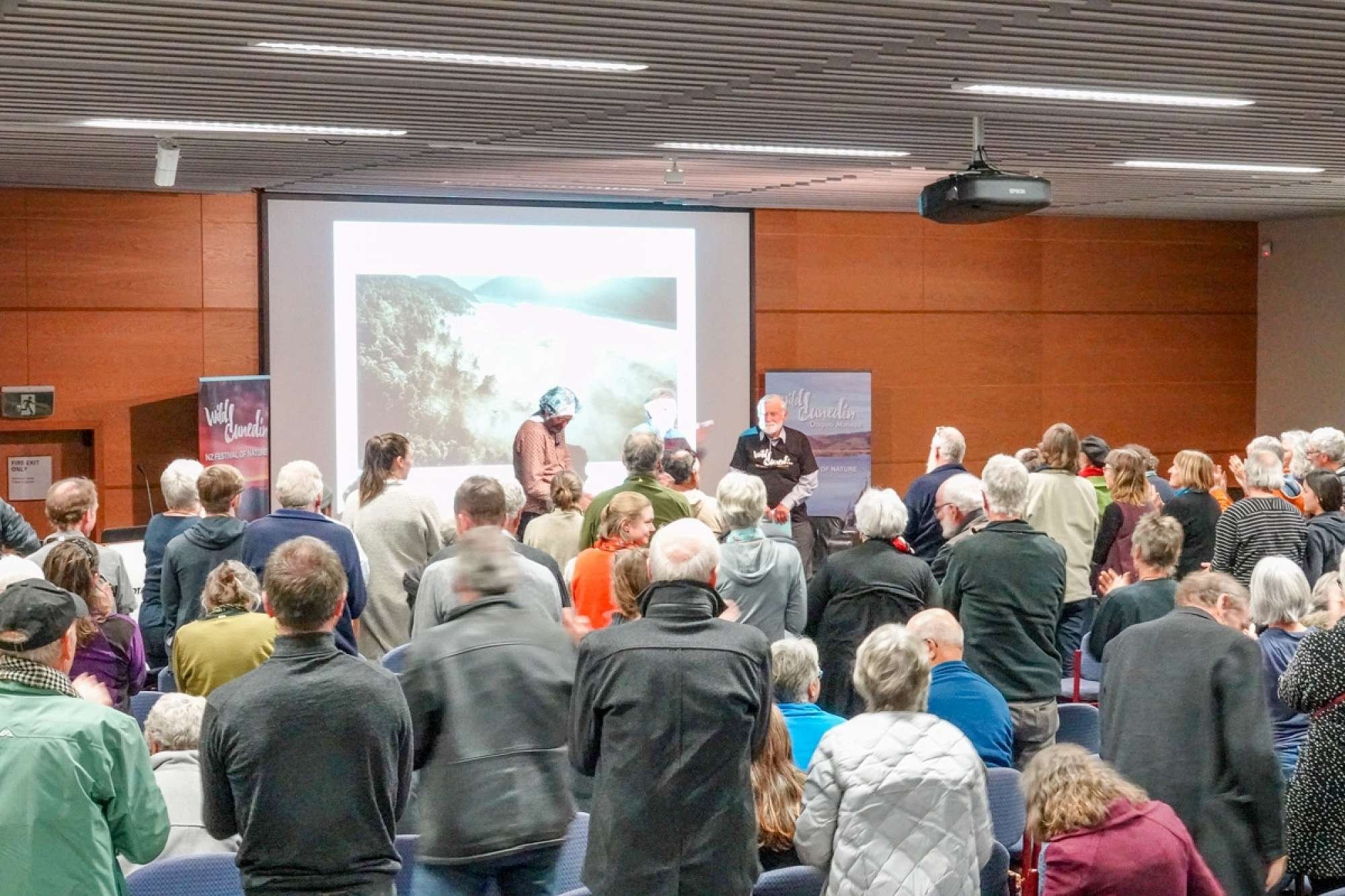Sir Alan Mark and Dr Mike Joy
Suzanne Middleton, Wild Dunedin — May 21, 2019
Host Peter Hayden began the conversation by asking if there was a moment when they became political on the issue of freshwater. For Alan it was when a senior public servant stated that raising Lake Manapouri would ‘improve on nature’. For Mike it was when his niece and nephew became ill after swimming in a river close to Palmerston North, and he discovered that wastewater was discharged into the river, and the local newspaper refused to publish an article on the Council’s role in the matter.
A Conversation with Dr Mike Joy and Sir Alan Mark with host Peter Hayden on New Zealand's Freshwater issues. Image by: Melissa Purnell
Following is a summary of the conversation that followed, starting with Alan outlining his research on the water-yielding properties of snow tussock...
Sir Alan Mark received the inaugural Wild Hero Award in association with the University of Otago for his lifetime’s work in conservation. Image by: Izumi Uchida-Schmidt
AM Now there’s general agreement that tall snow tussock on the mountain tops is extremely valuable and irreplaceable in terms of maximising the water we get off those mountains for various uses in the lowlands. . . . I’ve been looking at how we might compensate the farmers for keeping the tall tussock.
This has led to over a million hectares of reserves created on tussock grassland.
PH In Dunedin we are fog drinkers. Tall tussocks are very efficient at grabbing the fog for useful water.
On Mt Cargill one tussock captures half a litre of water per hour from fog. The nutrients in the water are so low that it’s almost like distilled water.
AM The mountains deliver water that’s as pure as any, down to the lowlands.
On the subject of the degradation of freshwater systems in New Zealand
MJ There are so many things going on but it’s about the intensification of agriculture and population. One of the best ways of integrating everything that happens in our rivers is to look at insects, invertebrates and larvae that live in the river and we calculate the score called the Macroinvertebrate Community Index. . . . Wastewater from cities is a really big problem but it’s really important to remember that our urban streams make up less than 1% of all our rivers whereas the rivers in pasture catchments make up 40%. So lowland parts of the country where we have intensive agriculture are where the problem is. . . . The reason we worry about the nutrients in waterways is what happens when the nutrients we put on the land to grow grass get into the rivers? When the sunlight is warm we grow algae in the water just like we grow grass. Algae’s great at low levels at the base of the food web but when it’s in abundance it causes all sorts of problems for the life in the streams. We put nitrogen fertiliser on the land to grow grass. We used to fix nitrogen back when I was dairy farming naturally using white clover, but now it comes from fossil fuel. A third comes from Taranaki gas, and two thirds is from the Middle East. We make artificial fertiliser to put on the farm land to grow grass, the cows eat it, a small amount goes out with the milk, the rest goes out in the urine . . . and it’s a huge volume of mostly nitrogen in a small area on the ground. The plant can’t take it up, it goes down past the roots and gets into the groundwater or the river. And that’s the issue we have here.
Dr Mike Joy explaining density changes of diary farming in the south. Image by: Izumi Uchida-Schmidt
MJ Now we’ve got this other issue that’s been highlighted – the nitrate in drinking water issue. And it’s a really big issue in parts of the country like Canterbury where most of the drinking water comes from groundwater. There’s been a huge study in Denmark . . . on the chances of getting colorectal cancer and getting it in relation to drinking water. Nine million people were in this Danish study over 25 years. They identified the levels of nitrates in drinking water that are associated with getting colorectal cancer. You get a significant increase in your chances at .87 mg of nitrates per litre of water. At 2.1 mg per litre you have a 15% increase in your chances of getting colorectal cancer. These are very similar numbers to the numbers for ecosystem health. .87 mg per litre should be the bottom line to protect ecosystems, and it turns out to be the bottom line if you’re going to drink the water. Over a lifetime your chances of getting colorectal cancer go up.
Dr Mike Joy. Imagy by: Izumi Uchida-Schmidt
In 2017 Mike Joy was awarded the New Zealand Universities’ Critic and Conscience of Society Award ($50,000) for his work in drawing attention to the issue of water quality in New Zealand’s rivers, lakes and drinking water.
MJ I spent half of the $50,000 on a really fancy nitrate detector so I could go out in the field and get freshwater samples. I teamed up with some people in Christchurch and people brought samples in and we drove around the countryside from town to town, went to the public toilets, filled up the container and tested water right through Canterbury. We collected 113 samples. Well over half of the people are drinking water well above the level of a 15% increase in risk. 80% of all samples exceed that number. We thought it was just in the rural areas with the shallower bores where they’ve got the problem. We thought Christchurch has a 187 metre deep bore so it should be OK. Of nearly 400 samples that the City Council had, from 2015 of drinking water from throughout Christchurch city, a third of them exceed that 15% chance. . . It’s an emerging issue and it’s the intensification of farming that’s driving it. About 1990 it started to really go crazy with dairy farming intensification. That was all sheep country. To achieve that meant getting rid of tens of thousands of trees in shelter belts to put in pivot irrigators, which is still going on. . . This is about converting from one farming system to another so that the land value is much increased on what it was before and then you have all of those issues that I’ve talked about. Who agreed to giving away this water to private owners like this? Did we get asked about that? 78% of the water used in New Zealand goes to irrigation and 76% of that goes to grow grass which is mostly for dairy.
Dr Mike Joy was our freshwater festival guest in 2019 - here having a conversation on our freshwater quality in New Zealand. Image by: Izumi Uchida-Schmidt
MJ I’m trying to summarise really quickly where we’re at. I’ve picked on nitrates because that’s the indicator that’s the big worry around colorectal cancer, because . . . this is human health, this is cancer, imagine the cost. . . The maximum allowable value for this is 11.3 mg nitrate-nitrogen per litre at the moment. That’s the worldwide standard and has been for 50 years. . . . The Ministry of Health then talk about risk to the water suppliers, that they’ll have to do something about finding a new source, not the risk of humans getting cancer. They didn’t even consider that to be a risk. It’s a huge issue. It’s become really clear to me that government won’t shift on this unless we make them shift. The tough decisions that this government will need to make will upset farmers because at the moment they’re making money by polluting the environment. They’re allowed to pollute the environment, and the tough laws will limit their ability to pollute fresh water and many of them will not be happy about that because their land values are being set, the money they’ve borrowed to buy the farm, the land value is set by that right to pollute, so it’s going to be a cost to them.
Dr Mike Joy explaining how nitrate levels will affect human health. Image by: Melissa Purnell
MJ We put a huge amount of resource into changing policy. We already have this amazing Resource Management Act, and it says quite clearly that you can’t do what we’re doing, but it’s still happened anyway. I gave that example of the wastewater treatment plant. It’s never once complied with its treatment conditions because nobody’s there enforcing or chasing it up. It’s a good reminder that it’s all very well having a policy in law but unless you’ve got someone to go in and enforce it then nothing will change. I know many farmers who want to cut back on fertiliser use and that kind of thing but the bank managers tell them they can’t. They see a risk. If they look at your workings and you’re spending less on fertiliser, and there’s a massive amount of debt, we’ve got $40 billion debt on dairy farms in New Zealand, it’s such a risk. So they’ll get told not to. That stewardship/husbandry thing is kind of under pressure from economic pressure.
Stunning freshwater images by Gilbert Van Reenan of Clean Green Images were projected throughout the conversation. Image by: Melissa Purnell
AM There’s some really intelligent work going on from Environment Southland . . . maximising return by minimising inputs. . . . It’s accepted through most of Southland.
MJ We’ve certainly got a government and Minister for the Environment David Parker who understands the issues, so there’s a whole lot of changes going on in the NES (national environmental standards) as well and work around how you test things and how you standardise it. It’s amazingly unorganised with everyone doing their own thing in the councils at the moment. Much more standardisation and much more money for monitoring are definitely part of the advice.
MJ There are two lakes in New Zealand, Lake Taupo and Lake Rotorua that we as taxpayers are currently paying dairy farmers not to intensively farm. We paid $90 million to reduce intensive farming in the Lake Taupo catchment and they have a cap and trade system with nitrate losses from there. . . . The scientists said we need to get 100 tonnes less nitrogen a year in Lake Rotorua. Here’s $40 million . . . not to farm, to get stock off that land. We pay farmers not to farm on two lakes in New Zealand, Taupo and Rotorua. We pay them $400 a kg for every kg of nitrate that they lose over a year. If we applied that over the whole country, I worked out roughly that we would have to pay $24 billion to dairy farmers in New Zealand not to dairy farm, to protect our waters, if we thought all our waters were roughly worth what Lake Rotorua and Lake Taupo were worth. Or in other words we are subsidising dairy farming in New Zealand to the tune of $24 billion to allow them to keep doing it. We need to rethink what we’re doing with our land in New Zealand because at the moment we’re propping up an industry that’s having massive impacts. And it’s not being fixed, it’s not being paid for. The cancer risk is a good example of how we’re leaving it for future generations to pay for.
Peter Hayden - Host of the Conversation. Image by: Izumi Uchida-Schmidt
PH Adaptation. We’re all going to have to adapt our lives to a new lifestyle. And honesty from scientists and politicians.
MJ There’s a desperation and understanding from many people and we know how real climate change is and how much faster it’s coming. All those predictions have an upper and lower band. It’s as bad or worse than anyone predicted and lots of those ideas people take as the science. But they are incredibly conservative, there’s a lot of conservatism among scientists naturally but there’s also lots of conservative pressure there. They don’t build in positive feedback loops that are going to make things worse. . . . When you know the reality and then you see Air NZ’s cheap fares, cruise ships, and SUV sales. There’s this big cognitive dissonance between what we know and how we live our lives and it’s a strange place to be watching it happen. . . . We’re going to have to live the change. I guess the message is we either change and manage our way through a pretty tough future that’s coming up or we just party on like we have been and then it’s going to hit us a lot worse.
MJ We’re going to have a managed decline here or we can let the crash come and there are lots of people my age in this room and we’ve had a great time in this one off fossil fuel frenzy, this legacy that we got left. In a dozen or so generations we’ve had this incredible life. We’ve built all these things like this, and now the reality’s starting to hit that it was a one off and we’ve squandered so much of it and I guess there’s a lot of belief out there that we’re going to carry on what we’re doing but there will be this green future with electric cars and electric scooters and bikes with solar panels on them and all that kind of stuff. And it ain’t gonna happen. You can’t do all that without fossil fuels. Renewables aren’t cancelling out fossil fuels, they’re adding to our use and we’re adding 90 million people to the planet every year so we’re going to have to face reality and we should have faced it a long time ago.
MJ 6% is the number at the moment, 6% reduction in fossil fuel use and greenhouse gas emissions which means we have to reduce GDP by 6% per year. So you think about if Jacinda was to bring out policies so we have a 6% reduction in GDP, how’s that going to go down with the electorate? There’s an example for me in the freshwater stuff where push push push we got the message out and we had 80% of people saying that freshwater is the most important thing so that gives the government the mandate and the confidence to do what we’re doing. . . . You don’t pass laws without support so if you’re going to take the kind of tough decisions we have to make, you have to have the people behind you. So people have to understand it to give the government support to do it.
Sir Alan Mark was awarded Wild Dunedin’s inaugural Wild Hero Award for his work in conservation for over 50 years. Image by: Jeannie Hayden
AM The public’s concern is clearly increasing and until we get more of that concern expressed freely and confidently by the public, the politicians will be lukewarm in terms of their response. Don’t underestimate the importance of the public response, the public support for the politicians to act. James Shaw said there’s been some delay in getting the Zero Carbon Bill tabled in the House . . . largely because they are discussing the details of the Bill with the National Party. Because as the Climate Leaders Coalition have said, unless there is cross party support for this Zero Carbon Act, industry and business will not offer their unqualified support. They need the confidence that this thing has support right across the political spectrum before they will be willing to respond in terms of the cost to modify their outlook.
AM So the public response and support for this issue is absolutely paramount. . . . Hopefully we’re getting the message out to a wider group and we hope that you will take the concerns that you are hearing here to your colleagues and friends and talk to your politicians. Your role is as important as our role because it’s a numbers game basically and the government has to feel confident that the public are behind them. With Manapouri Norman Kirk knew he was onto a winner because of the support he was getting all round the country and the Nats were getting rubbished when they spoke on the issue.
AM Once we get the Zero Carbon Bill drafted I hope that then we can have a major issue before us to discuss and debate and hopefully get support, rural and urban, and that might give us the catalyst to follow up the sort of thing that Hendrik (Moller) here has been suggesting. We could ask the Otago Regional Council to do more in the public arena. Their Regional Policy Statement which has been in process for the last three years is virtually complete. It’s got strong statements about their responsibility for implementing and promoting the need for climate change.
Alan getting the audience to pass a motion that he can take to Otago Regional Council. Image by: Izumi Uchida-Schmidt
I’d like to see a resolution from this meeting and I’d be very pleased to take it to Mr Stephen Woodhead, Chair of the Regional Council, and ask them to get off their butt and do something to promote and urban/rural liaison discussion of this issue of climate change and bring the community together. It’s their role as the Regional Council. The ORC clearly has the ability, it’s in their manifesto, it’s in their Regional Policy Statement, we should ask them to get off their butt and actually do it.
PH The image came to me of a relay race on behalf of the environment. And there you had Team Nature Alan Mark holding the baton, and there’s Team Vested Interest next to them, and there’s Team Growth at any Cost next to them. And Alan sets off and sets a blistering pace as he’s done for many years in all of his advocacy, and in the distance waiting for the baton is Mike Joy. So we watch them come in and he’s got Growth at any Cost breathing down his neck, they make a clean exchange and off goes Mike Joy with his ears pinned back, going like crazy, watching his competitors but looking over his shoulder. And there’s Alan Mark running beside him and the two of them exchange a big grin and give each other the thumbs up. That’s the sort of guys we have here and we all thank them very much.
A standing ovation was given by the audience to the speakers. Image by: Izumi Uchida-Schmidt


